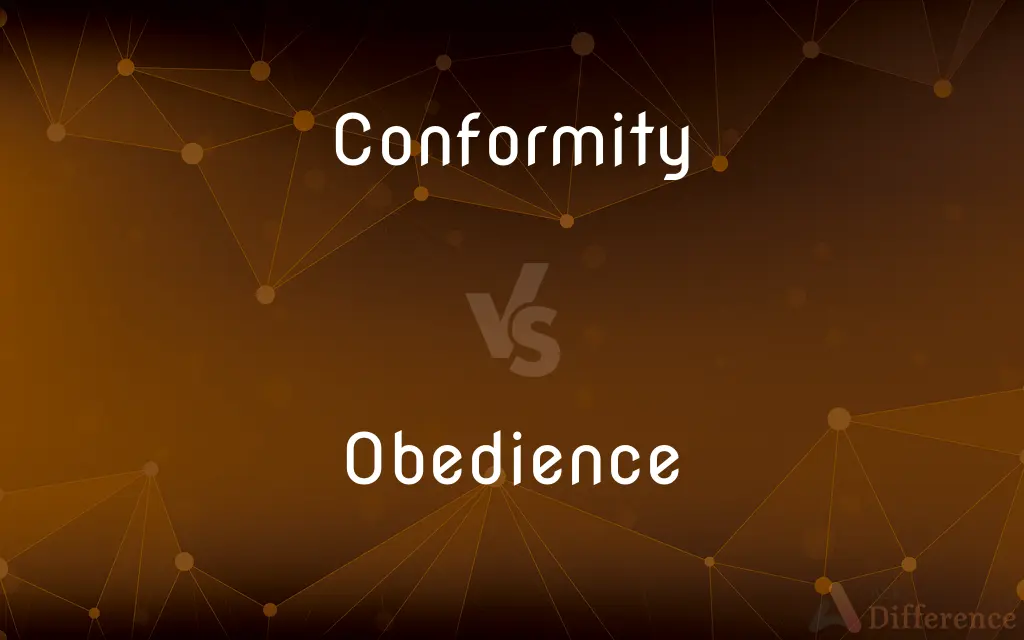Conformity vs. Obedience — What's the Difference?
By Tayyaba Rehman & Fiza Rafique — Updated on March 21, 2024
Conformity involves adjusting behaviors or beliefs to align with group norms, driven by the desire for social acceptance, whereas obedience is following orders from an authority figure, often without question.

Difference Between Conformity and Obedience
Table of Contents
ADVERTISEMENT
Key Differences
Conformity is the psychological phenomenon where individuals adjust their attitudes, beliefs, or behaviors to align with the group norms, primarily driven by the desire to fit in or be accepted by others. In contrast, obedience involves individuals following orders or instructions from an authority figure, often without questioning or fully understanding the rationale behind those orders.
Conformity can occur in both explicit and implicit social situations, indicating the influence of the group's presence, real or imagined, on the individual's choices. On the other hand, obedience usually requires the presence or directive of an authority figure, emphasizing a hierarchical relationship rather than peer influence.
While conformity is often motivated by the individual's desire for social acceptance or to avoid the discomfort of standing out, obedience is driven by the authority of the person giving orders, suggesting a more external motivation related to power dynamics rather than social belonging.
The mechanisms of conformity can involve changing one's behavior to match that of others in a group, even if it contradicts personal beliefs or preferences, showcasing a more passive form of influence. Conversely, obedience typically involves a direct request or command from an authority, requiring active compliance.
Conformity can lead to positive outcomes such as social harmony and group cohesion when the group norms are constructive. However, obedience, particularly when it involves unethical or harmful orders, can lead to negative consequences, highlighting the importance of ethical considerations in the authority-subordinate relationship.
ADVERTISEMENT
Comparison Chart
Definition
Adjusting behaviors or beliefs to align with group norms.
Following orders from an authority figure.
Motivation
Desire for social acceptance.
Authority of the person giving orders.
Influence
Peer group or societal norms.
Hierarchical relationship or direct command.
Mechanism
Passive adaptation to group norms.
Active compliance with specific directives.
Outcome
Social harmony and cohesion.
Compliance, potentially leading to negative consequences if orders are unethical.
Compare with Definitions
Conformity
Driven by the need for approval and fear of rejection from the group.
Her conformity in the group discussions was motivated by a desire to be liked.
Obedience
Involves following specific instructions or orders from authority figures.
Obedience to the company's safety protocols was mandatory for all employees.
Conformity
Influence comes from members of one's peer group or society at large.
Teenagers often show conformity by dressing similarly to their friends.
Obedience
Direct influence from someone in a higher position.
The teacher's strict rules required obedience from all students.
Conformity
Can result in greater social cohesion and acceptance within a group.
Her conformity to team norms helped improve overall group harmony.
Obedience
Comes from recognizing and respecting the authority of the person issuing commands.
His obedience stemmed from a deep respect for the law and its enforcers.
Conformity
The process of adjusting one's behavior or thinking to match those of other people or a group standard.
To blend in with his new colleagues, he adopted their work habits and attire, a clear sign of conformity.
Obedience
Can lead to compliance with rules and orders, beneficial or harmful.
Their obedience during the emergency drill ensured everyone's safety.
Conformity
Involves adapting to fit into a group, which can be positive or negative.
Conformity led him to volunteer more often, influenced by his community-oriented friends.
Obedience
The act of following orders or directions from someone in a position of authority, often without questioning them.
The soldiers' obedience to their commander's orders was immediate.
Conformity
Conformity is the act of matching attitudes, beliefs, and behaviors to group norms, politics or being like-minded. Norms are implicit, specific rules, shared by a group of individuals, that guide their interactions with others.
Obedience
The quality or condition of being obedient.
Conformity
Similarity in form or character; agreement
I acted in conformity with my principles.
Obedience
The act of obeying.
Conformity
Action or behavior in correspondence with socially accepted standards, conventions, rules, or laws
Conformity to university regulations.
Obedience
A sphere of ecclesiastical authority.
Conformity
The relationship between rock or sediment strata that were deposited adjacently or vertically in sequence without any interruption due to erosion, tilting, folding, or similar natural processes.
Obedience
A group of people under such authority.
Conformity
A surface exhibiting such a relationship between older rock strata and younger rock strata.
Obedience
The quality of being obedient.
Obedience is essential in any army.
Conformity
The state of things being similar or identical.
Obedience
The collective body of persons subject to any particular authority.
Conformity
A point of resemblance; a similarity.
Obedience
A written instruction from the superior of an order to those under him.
Conformity
The state of being conforming, of complying with a set of rules, with a norm or standard.
Obedience
Any official position under an abbot's jurisdiction.
Conformity
The ideology of adhering to one standard or social uniformity.
Obedience
The act of obeying, or the state of being obedient; compliance with that which is required by authority; subjection to rightful restraint or control.
Government must compel the obedience of individuals.
Conformity
Correspondence in form, manner, or character; resemblance; agreement; congruity; - followed by to, with, or between.
By our conformity to God.
The end of all religion is but to draw us to a conformity with God.
A conformity between the mental taste and the sensitive taste.
Obedience
Words or actions denoting submission to authority; dutifulness.
Conformity
Compliance with the usages of the Established Church.
The king [James I.] soon afterward put forth a proclamation requiring all ecclesiastical and civil officers to do their duty by enforcing conformity.
Obedience
A following; a body of adherents; as, the Roman Catholic obedience, or the whole body of persons who submit to the authority of the pope.
Conformity
Correspondence in form or appearance
Obedience
The act of obeying; dutiful or submissive behavior with respect to another person
Conformity
Acting according to certain accepted standards
Obedience
The trait of being willing to obey
Conformity
Orthodoxy in thoughts and belief
Obedience
Behavior intended to please your parents;
Their children were never very strong on obedience
He went to law school out of respect for his father's wishes
Conformity
Concurrence of opinion;
We are in accord with your proposal
Conformity
Hardened conventionality
Common Curiosities
Can conformity lead to negative consequences?
Yes, when group norms are harmful or unethical, conformity can lead to negative outcomes.
How does peer pressure relate to conformity?
Peer pressure is a form of social influence that can lead to conformity, as individuals may change their behavior to align with their peers’ expectations.
How do cultures influence conformity and obedience?
Cultural values and norms significantly influence the level and forms of conformity and obedience, with some cultures placing higher value on collective harmony or respect for authority.
Is obedience always a direct response to an explicit command?
Yes, obedience typically involves responding to direct, explicit commands or orders from an authority figure.
Are there any positive examples of obedience?
Following safety protocols during emergencies is a positive example of obedience, where compliance can save lives.
What's the main difference between conformity and obedience?
Conformity is adjusting one’s behavior to align with the group norms, while obedience involves following specific orders from an authority figure.
Can someone exhibit both conformity and obedience?
Yes, an individual can exhibit both by conforming to group norms and obeying authority within the same context.
Why is obedience considered to have a hierarchical aspect?
Because it involves a subordinate responding to the directives of someone in a position of authority, highlighting a power dynamic.
Is conformity always a conscious choice?
Conformity can be both conscious and unconscious, as individuals may not always be aware of why they are adopting certain behaviors.
Can obedience be ethical?
Obedience is ethical when the orders followed are morally just and serve a beneficial purpose for society or the group.
Can the fear of punishment lead to conformity?
Yes, the fear of punishment or negative consequences can motivate conformity to avoid social disapproval or exclusion.
Is it possible to resist conformity and obedience?
Individuals can resist both through self-awareness, critical thinking, and the courage to stand against group pressure or unjust authority.
How do social roles influence obedience?
Social roles, which include defined expectations and authority levels, significantly influence obedience by establishing who has the right to give orders.
How do groups enforce conformity?
Groups can enforce conformity through social cues, explicit rules, and the potential for social exclusion or other forms of social punishment.
What role does authority play in conformity?
While conformity is mainly about aligning with peer norms, authority figures can indirectly influence conformity by setting or endorsing those norms.
Share Your Discovery

Previous Comparison
Cataphoresis vs. Anaphoresis
Next Comparison
Thought vs. OpinionAuthor Spotlight
Written by
Tayyaba RehmanTayyaba Rehman is a distinguished writer, currently serving as a primary contributor to askdifference.com. As a researcher in semantics and etymology, Tayyaba's passion for the complexity of languages and their distinctions has found a perfect home on the platform. Tayyaba delves into the intricacies of language, distinguishing between commonly confused words and phrases, thereby providing clarity for readers worldwide.
Co-written by
Fiza RafiqueFiza Rafique is a skilled content writer at AskDifference.com, where she meticulously refines and enhances written pieces. Drawing from her vast editorial expertise, Fiza ensures clarity, accuracy, and precision in every article. Passionate about language, she continually seeks to elevate the quality of content for readers worldwide.














































